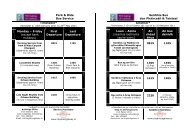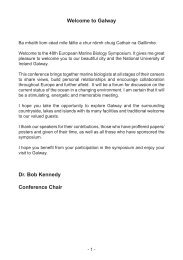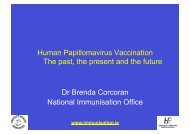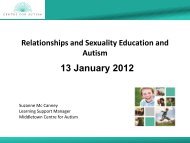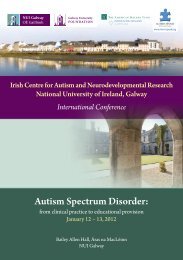International Center Board of Directors Dear Service ... - Conference.ie
International Center Board of Directors Dear Service ... - Conference.ie
International Center Board of Directors Dear Service ... - Conference.ie
Create successful ePaper yourself
Turn your PDF publications into a flip-book with our unique Google optimized e-Paper software.
and lack <strong>of</strong> knowledge and ability on the part <strong>of</strong> beginning<br />
teachers who use service-learning to build a support system<br />
for educational reform.<br />
What can be done to enhance the use <strong>of</strong> service-learning<br />
in teacher education?<br />
Panelists <strong>of</strong>fered numerous suggestions for improving<br />
the status <strong>of</strong> service-learning in teacher education. One<br />
approach to organizing these ideas is to arrange them as: 1)<br />
top down; 2) bottom up; 3) outside in; and 4) inside out.<br />
Top down strateg<strong>ie</strong>s<br />
The National Council for the Accreditation <strong>of</strong> Teacher<br />
Education (NCATE) has established standards that teacher<br />
education programs must meet in order to receive national<br />
accreditation, and in some states, to be accredited by the<br />
state to prepare and recommend teacher candidates for state<br />
licensure. As a result, these standards play an extremely<br />
powerful role in shaping the curriculum <strong>of</strong> teacher<br />
education programs. Very recently, NCATE has for the first<br />
time incorporated service-learning into Standard Three,<br />
which relates to f<strong>ie</strong>ld exper<strong>ie</strong>nces and clinical practice.<br />
This revision <strong>of</strong> the standard has the potential to encourage<br />
many teacher educators to “feel safe” that using servicelearning<br />
is an approach that will be v<strong>ie</strong>wed favorably by<br />
NCATE and state accreditors. <strong>Service</strong>-learning advocates<br />
need to continue to advocate for the inclusion <strong>of</strong> servicelearning<br />
in additional NCATE standards—especially,<br />
Standard One, which relates to “Candidate knowledge,<br />
skills, and pr<strong>of</strong>essional dispositions” and Standard Four<br />
which focuses on “Diversity.”<br />
Another top-down strategy involves the establishment<br />
<strong>of</strong> statewide task forces including students, parents,<br />
researchers, teacher educators, representatives <strong>of</strong> K-12<br />
education, and nonpr<strong>of</strong>it organizations and businesses<br />
exper<strong>ie</strong>nced with service-learning to develop a<br />
comprehensive statewide plan for implementing servicelearning<br />
that includes a strong teacher education<br />
component. This group should advocate for K-12 schools<br />
and teacher education programs to address a broad range <strong>of</strong><br />
student learning needs ranging from academic ach<strong>ie</strong>vement<br />
to civic responsibility, personal and social development,<br />
career exploration, and appreciation <strong>of</strong> community and<br />
diversity. Highlighting the civic mission <strong>of</strong> schooling will<br />
help bring service-learning to the forefront as a method to<br />
develop strong democratic citizens.<br />
This advocacy group also needs to focus on convincing<br />
policy makers to employ multiple measures to determine<br />
the success <strong>of</strong> students, teachers, or schools. Informal<br />
teacher assessments, portfolios, and community impact<br />
measures should be used in tandem with standardized tests<br />
to determine the effectiveness <strong>of</strong> our education.<br />
Bottom up strateg<strong>ie</strong>s<br />
Students and their parents in K-12 schools who have<br />
exper<strong>ie</strong>nced the benefits <strong>of</strong> service-learning need to<br />
advocate for its use with local school boards and school<br />
administrators. Teacher candidates who recognize the<br />
potential <strong>of</strong> service-learning should be vocal about their<br />
expectations for service-learning exper<strong>ie</strong>nces and training<br />
in the use <strong>of</strong> service-learning as a pedagogy when they<br />
select a teacher preparation program. K-12 administrators<br />
and teachers should expect new hires to come with<br />
knowledge and exper<strong>ie</strong>nce with service-learning.<br />
Higher education institutions that prepare administrators<br />
for K-12 schools need to be sure their graduates understand<br />
what service-learning is, how it can benefit all students and<br />
communit<strong>ie</strong>s, and what they need to do as administrators<br />
to facilitate successful service-learning at the building and<br />
district level.<br />
Teacher educators and those who conduct research<br />
on teacher education can support service-learning by<br />
conducting stud<strong>ie</strong>s that demonstrate the impacts <strong>of</strong><br />
service-learning participation on K-12 students, teacher<br />
candidates, and communit<strong>ie</strong>s. Research is also needed to<br />
help determine the best methods to implement servicelearning<br />
in teacher education, and how to institutionalize it<br />
to ensure its sustainability in a teacher education program.<br />
Outside in strateg<strong>ie</strong>s<br />
Teacher education is a complex undertaking that involves<br />
numerous stakeholders, including K-12 schools, teachers,<br />
administrators, districts, institutions <strong>of</strong> higher education<br />
that have teacher preparation programs, state departments<br />
<strong>of</strong> education, national accreditation agenc<strong>ie</strong>s, national<br />
pr<strong>of</strong>essional organizations, and the U.S. Department<br />
<strong>of</strong> Education, among others. <strong>Service</strong>-learning is also<br />
complex and involves a wide var<strong>ie</strong>ty <strong>of</strong> stakeholders.<br />
To make changes in both these areas is going to require<br />
systems thinking that will necessitate bringing together<br />
representatives <strong>of</strong> all the groups listed above. The<br />
Corporation for National and Community <strong>Service</strong> (CNCS)<br />
must work in close collaboration with the U.S. Department<br />
<strong>of</strong> Education (USDoE), NCATE, AACTE, and other<br />
organizations to develop the will and specific plans to<br />
support the integration <strong>of</strong> service-learning into teacher<br />
preparation programs. In the past, service-learning has been<br />
seen by too many educators as a “nice” add-on activity that<br />
might do good but was a distraction from the real work <strong>of</strong><br />
schools. This understanding and attitude must be changed<br />
at all levels, ranging from the CNCS and USDoE to local<br />
elementary schools and colleges <strong>of</strong> education.<br />
One way to begin this process is to establish an Office <strong>of</strong><br />
<strong>Service</strong>-Learning or Community-Engaged Learning in<br />
the USDoE. Another approach is to revive the CHESP<br />
grants—funds from the CNCS that required K-12,<br />
20



